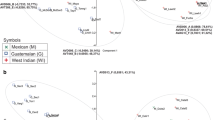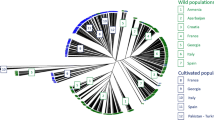Abstract
A total of 41 accessions of Aglianico belonging to three different biotypes (Taburno, Taurasi, and Vulture) and 9 accessions of Sirica grapes were sampled from diverse areas of Campania (Italy). All accessions were first genotyped using 21 microsatellite markers (SSR) to evaluate possible homonymies, synonymies, and the genetic structure of each group. A larger dataset was then constructed adding Italian and International cultivars. On the basis of results obtained analyzing the first dataset, further investigations were carried out enlarging the number of investigated loci (up to 43). The addition of 22 SSRs was useful in the definition of likely genetic relationships linking Aglianico biotypes, Sirica and Syrah. According to their SSR allelic profiles, the monophyletic origin of the three Aglianico biotypes was confirmed. Among Aglianico Taburno accessions, eight samples (called Aglianico like-to-type) performed a different SSR allelic profile from Aglianico true-to-type. Sirica and Syrah proved to be synonyms. This work allowed to determine the genetic relationship between Aglianico and the cultivars supposed to be related. The parentage analysis was investigated. The most likely pedigree has been reconstructed; revealing a second-degree relationship between the worldwide cultivated Syrah from the Rhone Valley and Aglianico. Aglianico like-to-type appeared related to Aglianico in a parent-offspring fashion.

Similar content being viewed by others
References
Costantini, L., Monaco, A., Vouillamoz, J. F., Forlani, M., & Grando, M. S. (2005). Genetic relationships among local Vitis vinifera cultivars from Campania (Italy). Vitis, 44, 25–34.
Scienza, A. (2003). Per una storia della viticoltura campana, in Vini e vitigni della Campania, tremila anni di storia. vol. 1. Scienza, A. and Boselli, M., (Eds.), (pp. 15–60). Napoli: Prismi.
Boselli, M. (2003). Gli Ambienti Campani, in Vini e vitigni della Campania, tremila anni di storia, vol. 1. Scienza, A. and Boselli, M., (Eds.), (pp. 61–74). Napoli: Prismi.
Caputo, A. R., Brini, M. L., Gasparro, M., Pepe, R., Coletta, A., & Antonacci, D. (2009). Recupero della biodiversità ampelografica dell’Aglianico a tutela della qualità del paesaggio viticolo (pp. 1–6). Zagreb: 32nd World Congress of Vine and Wine.
Thomas, M. R., & Scott, N. S. (1993). Microsatellite repeats in grapevine reveal DNA polymorphisms when analysed as sequence-tagged sites (STSs). Theoretical and Applied Genetics, 86, 985–990.
Thomas, M. R., Cain, P., & Scott, N. S. (1994). DNA typing of grapevines: A universal methodology and database for describing cultivars and evaluating genetic relatedness. Plant Molecular Biology, 25, 939–949.
Sefc, K. M., Regner, F., Glossl, J., & Steinkellner, H. (1998). Genotyping of grapevine and rootstock cultivars using microsatellite markers. Vitis, 37, 15–20.
Cipriani, G., Spadotto, A., Jurman, I., Di Gaspero, G., Crespan, M., Meneghetti, S., et al. (2010). The SSR-based molecular profile of 1,005 grapevine (Vitis vinifera L.) accessions uncovers new synonymy and parentages, and reveals a large admixture amongst varieties of different geographic origin. Theoretical and Applied Genetics, 121, 1569–1585.
Laucou, V., Lacombe, T., Dechesne, F., Siret, R., Bruno, J. P., Dessup, M., et al. (2011). High throughput analysis of grape genetic diversity as a tool for germplasm collection management. Theoretical and Applied Genetics, 122, 1233–1245.
Sefc, K. M., Steinkellner, H., Gloessl, J., Kampfer, S., & Regner, F. (1998). Reconstruction of a grapevine pedigree by microsatellite analysis. Theoretical and Applied Genetics, 97, 227–231.
Vouillamoz, J., Maigre, D., & Meredith, C. P. (2003). Microsatellite analysis of ancient alpine grape cultivars: Pedigree reconstruction of Vitis vinifera L. ‘Cornalin du Valais’. Theoretical and Applied Genetics, 107, 448–454.
Vouillamoz, J. F., Monaco, A., Costantini, L., Stefanini, M., Scienza, A., & Grando, M. S. (2007). The parentage of ‘Sangiovese’, the most important Italian wine grape. Vitis, 46, 19–22.
Bowers, J. E., & Meredith, C. P. (1997). The parentage of a classic wine grape, Cabernet Sauvignon. Nature Genetics, 16, 84–87.
Bowers, J. E., Dangl, G. S., & Meredith, C. P. (1999). Development and characterization of additional microsatellite DNA markers for grape. American Journal of Enology and Viticulture, 50, 243–246.
Vouillamoz, J. F., & Grando, M. S. (2006). Genealogy of wine grape cultivars: Pinot is related to Syrah. Heredity, 97, 102–110.
Schneider, A., Torello Marinoni, D., & Crespan, M. (2008). Genetics and ampelography trace the origin of Muscat fleur d’oranger. American Journal of Enology and Viticulture, 59, 200–204.
Crespan, M., Calò, A., Giannetto, S., Sparacio, A., Storchi, P., & Costacurta, A. (2008). ‘Sangiovese’ and ‘Garganega’ are two key varieties of the Italian grapevine assortment evolution. Vitis, 47, 97–104.
Di Vecchi Staraz, M., Bandinelli, R., Boselli, M., This, P., Boursiquot, J. M., Laucou, V., et al. (2007). Genetic structuring and parentage analysis for evolutionary studies in grapevine: Kin group and origin of the cultivar Sangiovese revealed. Journal of the American Society for Horticultural Science, 132, 514–524.
Bergamini, C., Caputo, A. R., Gasparro, M., Perniola, R., Cardone, M. F., & Antonacci, D. (2012). Evidences for an alternative genealogy of ‘Sangiovese’. Molecular Biotechnology. doi:10.1007/s12033-012-9524-9.
Sefc, K. M., Regner, F., Turetschek, E., Glossl, J., & Steinkellner, H. (1999). Identification of microsatellite sequences in Vitis riparia and their applicability for genotyping of different Vitis species. Genome, 42, 367–373.
Bowers, J. E., Dangl, G. S., Vignani, R., & Meredith, C. P. (1996). Isolation and characterization of new polymorphic simple sequence repeat loci in grape (Vitis vinifera L.). Genome, 39, 628–633.
Peakall, R., & Smouse, P. E. (2006). GENALEX 6: Genetic analysis in Excel. Population genetic software for teaching and research. Molecular Ecology Notes, 6, 288–295.
Wang, J. (2011). COANCESTRY: A program for simulating, estimating and analysing relatedness and inbreeding coefficients. Molecular Ecology Resources, 11, 141–145.
Lynch, M., & Ritland, K. (1999). Estimation of pairwise relatedness with molecular markers. Genetics, 152, 1753–1766.
Wang, J. (2002). An estimator for pairwise relatedness using molecular markers. Genetics, 160, 1203–1215.
Vouillamoz, J. F., Maigre, D., & Meredith, C. P. (2004). Identity and parentage of two alpine grape cultivars from Switzerland (Vitis vinifera L. Lafnetscha and Himbertscha). Vitis, 43, 81–87.
Vouillamoz, J. F., Schneider, A., & Grando, M. S. (2007). Microsatellite analysis of Alpine grape cultivars (Vitis vinifera L.): Alleged descendants of Pliny the Elder’s Raetica are genetically related. Genetic Resources and Crop Evolution, 54, 1095–1104.
Vouillamoz, J. F., & Arnold, C. (2010). Microsatellite pedigree reconstruction provides evidence that ‘Müller-Thurgau’ is a grandson of ‘Pinot’ and ‘Schiava Grossa’. Vitis, 49, 63–65.
El Oualkadi, A., Ater, M., Messaoudi, Z., Heit, K. E., Laucou, V., Boursiquot, J. M., et al. (2011). Genetic diversity of Moroccan grape accessions conserved ex situ compared to Maghreb and European gene pools. Tree Genetics and Genomes, 7, 1287–1298.
This, P., Jung, A., Boccacci, P., Borrego, J., Botta, R., Costantini, L., et al. (2004). Development of a standard set of microsatellite reference alleles for identification of grape cultivars. Theoretical and Applied Genetics, 109, 1448–1458.
This, P., Lacombe, T., & Thomas, M. R. (2006). Historical origins and genetic diversity of wine grapes. Trends in Genetics, 22, 511–519.
Crespan, M. (2004). Evidence on the evolution of polymorphism of microsatellite markers in varieties of Vitis vinifera L. Theoretical and Applied Genetics, 108, 231–237.
Schlotterer, C., & Tautz, D. (1992). Slippage synthesis of simple sequence DNA. Nucleic Acids Research, 20, 211–215.
Myles, S., Boyko, A., Owens, C., Brown, P., Grassi, F., Aradhya, B., et al. (2011). Genetic structure and domestication history of the grape. PNAS, 108, 3530–3535.
Bisson, J. (1999). Essai de classement des cépages français en écogéogroupes phénotypiques. Journal International des Sciences de la Vigne et du Vin, 33, 105–110.
Bowers, J. E., Siret, R., Meredith, C. P., This, P., & Boursiquot, J. M. (2000). A single pair of parents proposed for a group of grapevine varieties in Northeastern France. Acta Horticultrae, 528, 129–132.
Vouillamoz, J. F., & Grando, M. S. (2007) Généalogie des cépages: le ‘Pinot’ est apparenté à la ‘Syrah’ (pp. 1–6), Budapest: 30th World Congress of Vine and Wine.
Meredith, C. P., & Boursiquot, J. M. (2008) Origins and importance of Syrah around the world (pp. 17–20), Lyon: International Syrah Symposium, Oenoplurimédia.
Acknowledgments
Joint publication of the COST Action FA1003 “East–West Collaboration for Grapevine Diversity Exploration and Mobilization of Adaptive Traits for Breeding.” This research was funded by Feudi di San Gregorio s.p.a winery. We thank Dr. A. Zappata (AGER s.c. AGricoltura E Ricerca, Milano, Italia) for providing samples.
Author information
Authors and Affiliations
Corresponding author
Rights and permissions
About this article
Cite this article
De Lorenzis, G., Imazio, S., Biagini, B. et al. Pedigree Reconstruction of the Italian Grapevine Aglianico (Vitis vinifera L.) from Campania. Mol Biotechnol 54, 634–642 (2013). https://doi.org/10.1007/s12033-012-9605-9
Published:
Issue Date:
DOI: https://doi.org/10.1007/s12033-012-9605-9




